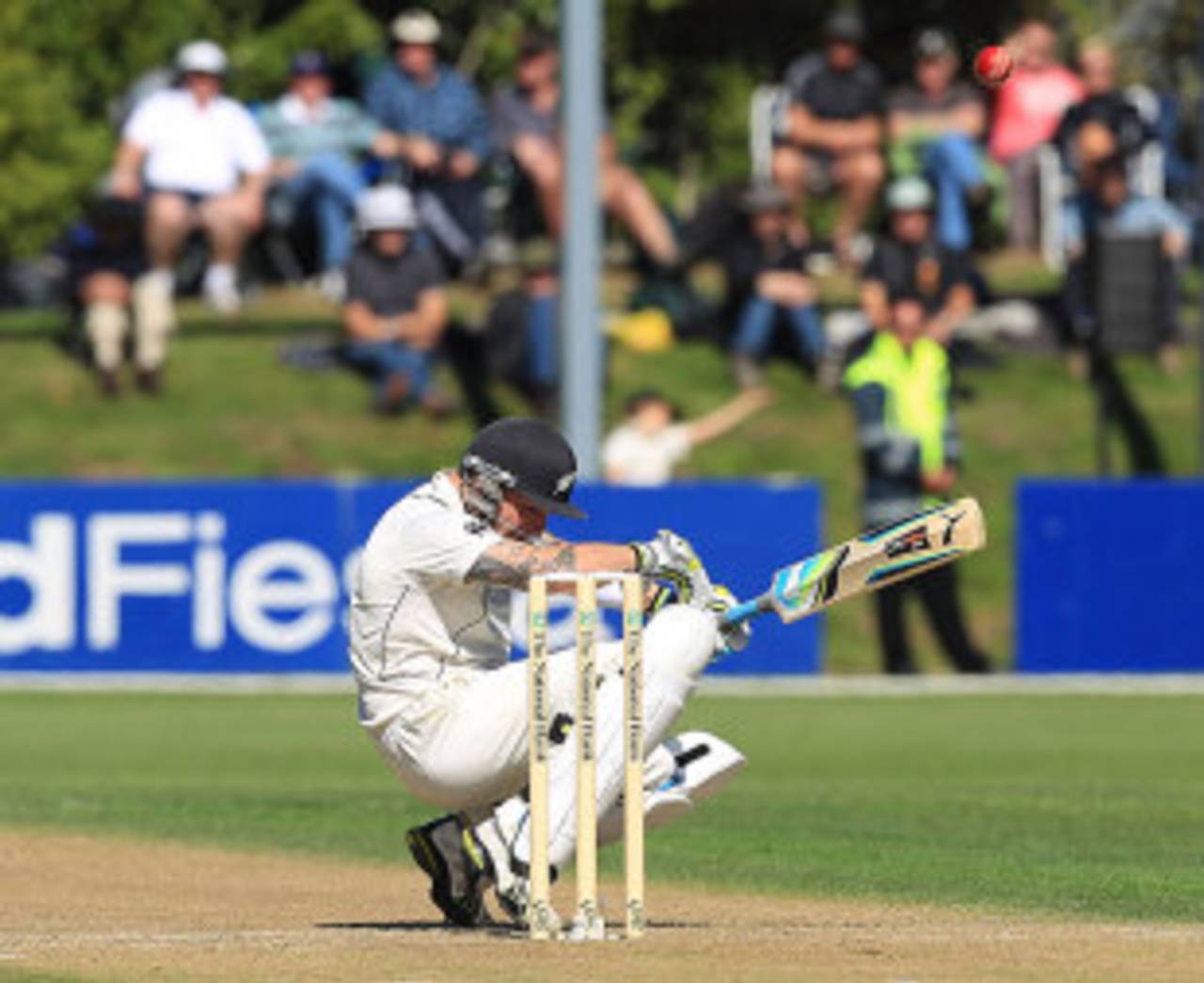Survival against a hostile bowling attack is an art and New Zealand's top-order batsmen were required to be the Van Goghs of that discipline on the second day in Dunedin. The strength of their technique and temperament against the new ball was tested by South Africa's fast bowlers, and later by the legspinner Imran Tahir, all of whom operated with aggression and rarely wavering discipline. New Zealand fought through the toughest phases, but when batting became easier and demanded more decision-making, they faltered.
The best form of defence is sometimes as simple as defence itself, as Brendon McCullum, Martin Guptill and Ross Taylor demonstrated. Against seaming, accurate balls delivered by Vernon Philander, Dale Steyn and Morne Morkel, the batsmen focused on not getting dismissed. Since they were not considering attack, they had only two options to choose from most of the time - defend or leave. There were plenty of risks to negotiate, but only because of the quality of the bowling, not because of the batsmen's approach. Their techniques were tested and they passed.
It was only after McCullum and Taylor had settled in after lunch, and began to look actively for scoring opportunities, that they contributed to the risks. Now they had to make more decisions, - leave, defend or attack - and prove their temperament and shot selection. Both fell to loose shots, eroding rapidly the platform they had toiled to build.
Philander and Steyn had opened with an anger that suggested they were unhappy with South Africa's batting performance. Unlike New Zealand's quicks, they made optimum use of warmer weather and 91% humidity to make the new ball, as Graeme Smith likes to call it, "talk." Steyn found movement both against and into the wind, while Philander barely moved from his line just outside off stump, getting balls to bounce and straighten off the pitch, and angle into the right-hand batsmen.
"The questions he [Philander] asked with the ball moving back into us was incredibly difficult," McCullum said after play. "He was incredibly challenging. The length that he was hitting and the ability to move the ball off the seam made it tough."
During the first seven overs, there was a danger of falling virtually every ball, as Rob Nicol's innings showed, and survival required careful consideration of when to leave. Run-scoring was almost incidental to New Zealand's main task. Either they came by mistake, like the outside edges Martin Guptill got away to third man, or under complete safety, like a rare ball straight enough for McCullum to push behind square. For almost 20 overs South Africa allowed no more than that and New Zealand displayed the grit necessary to hold off some of the world's best bowlers. They were particularly adept at standing up against the bounce to play the short ball down.
Guptill was dismissed in the first over after lunch, when he left a rare gap between bat and body while defending, but Taylor continued the vigil. Morkel hit Taylor and McCullum twice each: Taylor on the sternum and shoulder, McCullum on the shoulder and groin. Though, his lines and lengths were not always meticulous, Morkel could cause pain. Even Tahir, who does not mind sacrificing economy in pursuit of wickets, maintained pressure with drift and sensible variations. New Zealand had only one option: defend.
"We've asked the guys to dig in and try and wear down the South African bowlers," McCullum said. The effect of bowling at what was essentially a wall eventually took its toll on South Africa. The first real boundary ball came at the end of the 20th over - too straight from Philander, allowing McCullum to whip through midwicket. Four overs later, Philander presented Taylor with a more hittable ball - short and asking to be pulled - and the birthday boy had a welcome release.
Boundary balls became more frequent and the pair settled into a rhythm of one an over. Taylor drove, McCullum pulled. Scoring opportunities opened up, but the loose balls had to be identified among several good ones and the right shot chosen and executed. Temperament was required to not get carried away. Some balls were full enough to be driven, some short enough to pull, while others were of the same line and length that demanded the watchfulness of earlier. The number of options had increased and a judicious selection was required.
Both McCullum and Taylor were dismissed choosing the new option - to attack - against deliveries they had defended and left earlier. McCullum top-edged a sweep against the turn of Tahir, and Taylor chased and edged an extremely wide ball from Morkel after hitting two fours in the same over.
"They were pretty loose shots. So it was disappointing from that point of view," McCullum said. "You work incredibly hard and you anticipate being able to kick on once the ball is a bit older. It's disappointing, if you make a mistake, especially a mental one like that."
Those two errors of judgment caused New Zealand to slide from a position where they had begun to dominate to one where they had to scrap to avoid a collapse. The batsmen that scrapped - Daniel Vettori, the debutant Kruger van Wyk and Doug Bracewell - did not have the most adept techniques, especially against Tahir, but they were careful in their shot selection. And by the time they were dismissed, due to the quality of the bowling, rather than their own indiscretions, New Zealand had inched past South Africa's total.
Edited by Siddarth Ravindran
Firdose Moonda is ESPNcricinfo's South Africa correspondent
